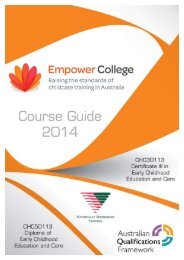Anaphylaxis Management Guidelines
You also want an ePaper? Increase the reach of your titles
YUMPU automatically turns print PDFs into web optimized ePapers that Google loves.
Keep a copy of the child’s ASCIA Action<br />
Plan (or know where to find one quickly)<br />
and ensure it is followed in the event of an<br />
allergic reaction.<br />
Know the risk minimisation strategies<br />
contained in a child’s Individual <strong>Anaphylaxis</strong><br />
Health Care Plan and ensure they<br />
are followed.<br />
Know where the child’s adrenaline<br />
autoinjector is kept. Remember that<br />
adrenaline autoinjector, is designed so that<br />
anyone can administer it in an emergency.<br />
Consider undertaking training in how to<br />
recognise and respond to an anaphylactic<br />
reaction. This training should include how to<br />
administer an adrenaline autoinjector.<br />
Be aware of the possibility of hidden<br />
allergens in foods and of traces of allergens<br />
when using items such as egg or milk<br />
cartons in art experiences.<br />
Plan ahead for special activities or<br />
occasions such as excursions, in house<br />
activities and parties. Work with parents/<br />
guardians to ensure that food provided for<br />
the child is appropriate.<br />
Avoid the use of food treats as rewards as<br />
these may contain hidden allergens.<br />
Consider the risk of cross-contamination<br />
when preparing, handling and<br />
displaying food.<br />
Ensure that tables and surfaces are wiped<br />
down regularly and that children wash their<br />
hands before and after handling food.<br />
Raise child awareness about severe<br />
allergies and the importance of their role in<br />
fostering an environment that is safe and<br />
supportive for other children.<br />
Coordinators<br />
Coordinators take a lead role in supporting<br />
child care staff to implement risk minimisation<br />
strategies for their service.<br />
Coordinators should:<br />
Keep an up to date register of children at<br />
risk of anaphylaxis.<br />
Obtain training in how to recognise<br />
and respond to an anaphylactic<br />
reaction, including administering an<br />
adrenaline autoinjector.<br />
Check regularly that the adrenaline<br />
autoinjector is not discoloured or out-of-date.<br />
Ensure that the adrenaline autoinjector is<br />
stored correctly (at room temperature and<br />
away from light) in an unlocked, easily<br />
accessible place, and that it is appropriately<br />
labelled. In hot climates, the adrenaline<br />
autoinjector should be stored in a small esky<br />
or similar container, but not refrigerated.<br />
12 <strong>Anaphylaxis</strong> <strong>Management</strong> <strong>Guidelines</strong>





